Founding
father and dog agility pioneer...
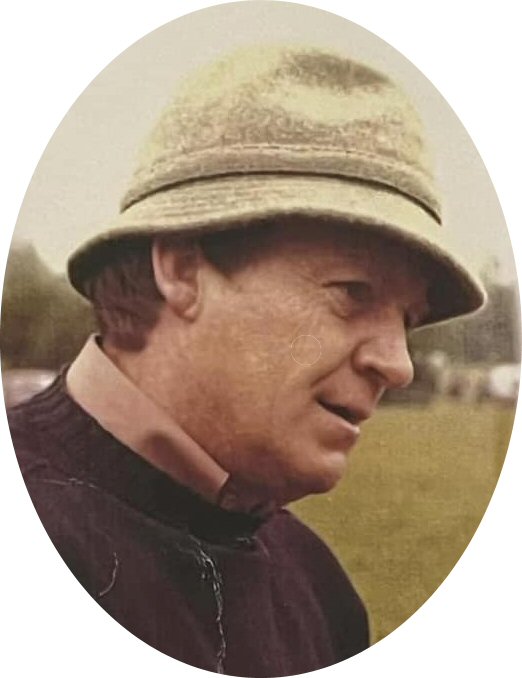 A short summary of
Peter Lewis' life could read something like... got a dog, trained it, won a few
trials, wrote some books, developed rules for some new dog pastimes, visited
some countries promoting them, owned some more dogs, re-invented his interests
and made a success of that, too. But, as with most people, there is much more to
his life than this. Steve Croxford looks back and reflects upon what Peter meant to the
agility world. A short summary of
Peter Lewis' life could read something like... got a dog, trained it, won a few
trials, wrote some books, developed rules for some new dog pastimes, visited
some countries promoting them, owned some more dogs, re-invented his interests
and made a success of that, too. But, as with most people, there is much more to
his life than this. Steve Croxford looks back and reflects upon what Peter meant to the
agility world.
I
was truly surprised after hearing of Peter Lewis' passing when I heard people
ask who he was so I decided to write this tribute.
Like
most of us, Peter's passion for dogs started at a young age. I recognise his
talk of ‘dogged' pleading with his father for a canine companion of his own. I
recall the same ‘discussions' with my own father. 'Why not?' answered with 'it
will just be a five-minute wonder.' Following a request that became a pattern in
his life. His demands were quite specific. He didn't want just any dog. He
wanted a black Labrador. Eventually, his persistence paid off, and he became the
proud owner of a black Labrador named Major, a gift from his father. And so it
was a that five-minute wonder became a lifelong passion.
A
creative and organised mind helped Peter succeed at most things he turned his
hand to. Whether it was sports like running, table tennis, cricket or soccer or
his business life, he was well respected and had a full and varied career.
He
was enthusiastic and clearly driven to make the best of whatever activity
he took an interest in. Inevitably this led him getting involved,
achieving success and in organising things to his liking.
 Early
days Early
days
In
the 1960s, Peter bought another Labrador called Bill from a Surrey farm.
After having contacted The Kennel Club for advice, he joined the Surrey Dog
Training Society, a club which, at the time, was involved in Championship Obedience and Working
Trials at the time with pet dog training. The club was keen on promoting and
encouraging new members to get involved in dog sports.
Having been encouraged to enter Obedience competitions by the club, it became
clear to Peter that there was more to obedience than he thought, and he couldn't
just turn up with Bill and win. He was determined to learn more.
Against the
advice of his then club Portsmouth Dog Training Club, he entered a Championship
Show at Epsom. There he realised that he needed to develop his
skills if he was ever going to win anything and plucked up the courage to
introduce himself to one of the handlers, Charlie Wyant, the renowned obedience
handler of this time. Over time Peter learned a lot from their relationship, and
Charlie remained a great influence on his training methods from then on.
Somewhat frustrated by dog training methods of the time, Peter suggested to
like-minded dog owners interested in working trials that they set up another
club, which became the Hampshire Working Trials Society. For people new to dogs
another club, the Solent Dog Training Club, was created. Peter was elected chairman of
both clubs.
Peter and Bill developed into serial winners at obedience Shows and together
they worked their way up to Championship C and Working Stake (PD), the top
level category for these two disciplines.
In
1972 Peter sadly became a widower when his wife Pam succumbed to cancer. This
seems to have spurred him on to becoming more and more involved in his hobbies, competing and judging at both obedience and
working trials. His organisational skills shone through and he became more
involved with the Kennel Club and in the administration and development of working
trials to the extent that he was elected to be chairman of the Working
Trials Council. His passion for developing the sport was rewarded when the
Kennel Club approved the rules for the Working Trials Championship, and in 1975
the first annual championship was held.
During this period Peter met his second wife, Carol, and between them they started a
publishing company called Canine Publications which saw great success with their
first book Heelaway Your Dog by Charlie Wyant.
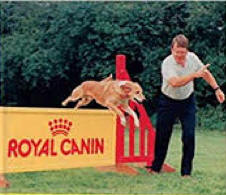 Writing the rules Writing the rules
As
the decade drew to a close, a new dog activity was demonstrated at Crufts, based
on some ideas put together by Peter Meanwell who had been asked to put on a
demonstration of ‘dog jumping' to fill in time in the main arena. The idea was
floated by John Varley of the Kennel Club, and the first demonstration took place
in 1978. It was clear by the response from the audience that this new ‘dog
jumping' event was going to be popular. Following up on a complaint to the
Kennel Club about 'unregulated' dog jumping events, the Working Trials and
Obedience Committee was asked to come up with some official regulations for
them. Peter was asked to sit on the sub-committee drafting the rules.
To
quote Peter, 'I left that meeting fired with enthusiasm for a new dog sport we
were going to call Agility as a title such as dog jumping did not sit easily
with the Kennel Club's image. I seem to recall it was around September time and
the rules were scheduled to be published soon and made effective from 1st
January 1980 after which clubs could then apply for a license to hold agility
tests.'
Peter then set about forming an agility group which he founded under the name of
the Burridge Dog Training Club. The training venue was at his home ground. One
of the early members of the club was one Lesley Olden, who quickly impressed him
with what seemed like a natural talent.
He said, 'For several years Lesley and I travelled
to shows together. After one show at Otley (Yorkshire), Lesley and her dog Midge
collected five faults for just one mistake. Lesley needed to dissect the problem
all the way home – that's a five-hour journey. After two hours I'd had
enough and there were three hours still to go! I suppose that is the
difference between the killer instinct and whose of us who are a little more
laid back. I was never that dedicated to success.'
During that first year there were only a handful of people taking part in
agility tests. However, during the summer of 1980 and, on behalf of Pedigree Chum,
John Varley, who sat on the Crufts Committee was running qualifying events for
that December's London Olympia International Horse Show Jumping competition as the
Raymond Brookes-Ward of this world had decided that agility looked like good
fun.
Again to quote Peter,
'Those early agility events were great but some of us were
concerned that there were still not enough ordinary agility shows to create a
circuit or tour. A few of us got together to hold a meeting which we loosely
called the Southern Agility Clubs. The meeting was held on the 5th
September 1980 at the house of CC Guard, together with Peter, Les Robinson, Jeff
Gunns, Roger Farr, Kay Lawrence, John Cheetham, Clair Oldfield, Jean Smith and
John Gilbert.'
It
was at this meeting that a number of points were agreed about how agility
competitions should be run. These details were accepted by the majority, but
there was still much to be sorted out. This would come with time and practice. Although the Kennel Club had published basic rules.
it was not prepared to go
beyond that for the time being.
So
it was that in December of 1980, 20 dogs and handlers arrived at Olympia for the
first national agility final. This was the first of half a dozen times that
Peter would qualify for Olympia with his dog.
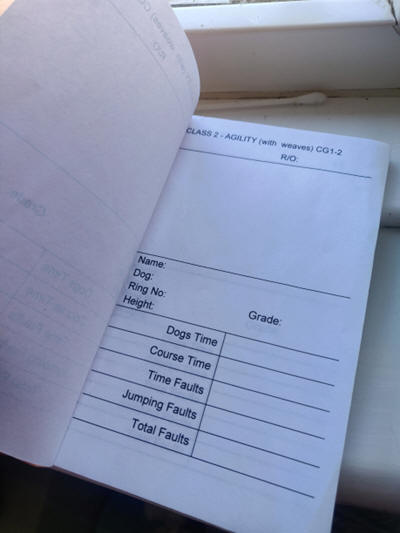 During this period, Peter got thinking about judging and scoring for the
agility
tests, based on the principles agreed at the September meeting. He designed a
score sheet which was called a 'scribe pad' to be used by the steward to write down
the marks indicated by the judge. All these systems were adopted by the sport,
and the signalling system he devised is still being used by judges today. During this period, Peter got thinking about judging and scoring for the
agility
tests, based on the principles agreed at the September meeting. He designed a
score sheet which was called a 'scribe pad' to be used by the steward to write down
the marks indicated by the judge. All these systems were adopted by the sport,
and the signalling system he devised is still being used by judges today.
His daughter Nicola recalls, 'I remember Dad telling me that when they formulated
the first rules for agility, it was suggested by the Kennel Club that they
copy the horse competing world by using four points for any faults, but Dad
said he preferred five points - a far simpler way to tot up the maths. He
was always thinking about anything he did with the mindset of how he could
improve upon this.'
In the latter part of 1980 Peter started writing The Agility Dog. it was to
be the first book about training for agility and how to run competitions. Peter
was aware that, as the first book on the subject, it would create a milestone - and it
did! This was followed by the publication of The Agility Dog International
in 1985.
The Agility Club
As
Agility grew more popular during these early years, it became obvious that a group
was needed to oversee the sport. Otherwise shows would descend into confusion.
Individual clubs were drawing up their own classifications for shows. The
Kennel Club had made it clear that they were not interested in overseeing
agility until it was more established.
It
was at this point that a small group of people decided that a degree of
uniformity was required. Between John Gilbert and Peter, the idea of
forming a national agility club was discussed. Once the idea was agreed, those enthusiastic few decided to discuss with fellow
competitors whether they would be interested. The response was overwhelmingly
positive. At the end of the day everyone was asked to write their name and address
on a piece of paper and donate £1 pound to enable the group to form a steering
committee. In the end, the grand sum of about £100 pounds was deposited in a
bucket. Within a few short weeks, The Agility Club was up and running.
At
the first meeting, Peter was elected as chairman and eventually its first
president. Over a period of time, the club was called upon to offer agility dog
handling courses, instructor courses and what became their pioneering two day
agility judging seminars. The first of these seminars was held in 1984 at the
Royal Veterinary College, Hatfield, Hertfordshire. These seminars became an
annual event in the UK and then became in great demand in other countries new to
the sport as the news spread of this new and exciting dog sport.
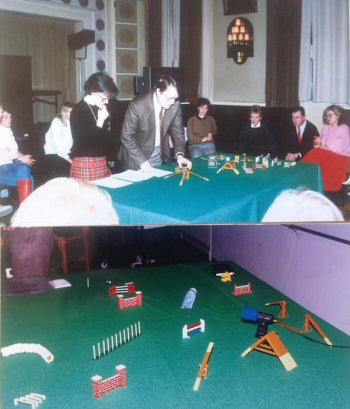 Spreading the word Spreading the word
Visitors to Crufts from other countries had begun to take an interest in this
new dog activity, and it wasn't long before other countries in Europe and North
America wanted to
join in the fun. The first country of note was Holland where Lois Van De Bogarde recognised the potential for the sport in her country.
A trip was organised so that Peter could introduce the sport to enthusiastic groups of
Dutch dog trainers.
So
an intrepid band of enthusiastic agility people including Roger Farr, Bill and Angela Chuter
and Peter Lewis set off from England in a minibus, towing a full set of agility
equipment behind them, to visit five Dutch clubs,
geographically spread across the country. Their aim was to teach about 100 handlers with
their dogs per
day. Somehow they managed to achieve their objectives, but it was a marathon task in
such a short time.
Being so close to Holland, it should come as no surprise that Belgium was
represented amongst those people attending the seminars. One of these was Wilf
Claes whose enthusiasm for agility led him to being at the forefront of its
introduction in his country.
Over
the following years Peter found himself travelling across Europe running judging
and handling seminars based on the courses initially set up by the Agility Club.
Without a doubt, it is because of these intrepid pioneers that agility developed
quickly across Europe and that, by and large, the same rules were adopted in each
country due to their influence.
In
1985 Peter was introduced to Royal Canin who were interested in sponsoring a dog
sport. Having seen agility at Olympia, they decided this would be a good vehicle
to promote their products to a new audience. Peter was told that Royal Canin
wanted to spread agility across Europe and asked if he could help. After some
discussion, Peter was offered a contract to be Royal Canin's agility consultant
which allowed him to visit countries of their choosing to teach and explain agility.
On
his first visit to France, Peter was introduced to Jean Paul Petitdidier, a
member of the Societé Centrale Canin (the French Kennel Club) and the Royal Canin
representative in France. Eventually, after some discussion with other delegates from the
French Kennel Club, it was agreed they would, more or less, adopt the
Agility framework that had been developed in the UK in full. Both Peter and
Jean-Paul were keen to see the same
agility rules adopted officially across Europe. According to Jean-Paul, the
best placed organisation to do this was the FCI.
With
the support of the French Kennel Club, Jean-Paul and Peter were able to persuade
the FCI to adopt the agility rules devised by them and so began the formal
introduction of official Agility rules across the world.
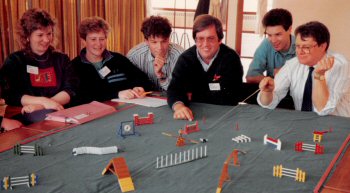 At
Crufts 1983, Peter and Carol met Ken Tatsch, an American from Texas.
They discussed agility at length and met up again the following
year. After some hard thinking, Ken saw the potential for developing something
new for dog lovers in the USA and he gave up his accountancy work to set up
the United States Dog Agility Association (USDAA) in 1986. At
Crufts 1983, Peter and Carol met Ken Tatsch, an American from Texas.
They discussed agility at length and met up again the following
year. After some hard thinking, Ken saw the potential for developing something
new for dog lovers in the USA and he gave up his accountancy work to set up
the United States Dog Agility Association (USDAA) in 1986.
During one of his trips to Europe, Peter became interested in the psychology of
dog behaviour. Following up on this interest, he became intrigued by this and
thought it would be something he might be able to turn into another consultancy
role. So after a period of study and reflection he began another chapter in his
life. After a number of years as a behaviourist, he wrote the last
book in his series of ten 'How to' series How to Change Dog Behaviour.
Involvement with The Kennel Club
Peter's long association with the Kennel Club and his work on
numerous committees led to him being appointed the judge for the Agility
competitions at Crufts in 1986. During this time, he also worked for the BBC as
the Agility pundit for their Crufts coverage alongside Peter Purves, a role
which he performed for seven years.
Peter
became a member of the Working Trials, Obedience and Agility Committee in 1993.
It was about this time that Bill Hardaway, vice-chairman of the Kennel Club, formed a
new committee to develop The Good Citizen Dog Training scheme.
Peter was also asked to join the board of The Kennel
Club Accredited Instructors Scheme for Dog Training and Canine Behaviour. Once
again his practical experience and talent for organisation and administration was put to good use.
This
was not the last time Peter would be called
upon to be creative with a new dog sport. It was during early 1990 that Peter got
involved with developing a series of videos highlighting the talents of a well-known dog trainer, Mary Ray. John Gilbert with whom Peter had worked in the past
had begun to develop the idea of showcasing Mary's talents during a performance
of An Evening with Mary Ray. John would ask Mary questions, and she would go
on to demonstrate her dog training and obedience skills with her dogs. The
climax of the evening was a performance of her competition obedience skills set
to music. It was not long before Mary was performing these fabulous heelwork demonstrations to appreciative audiences at Crufts.
An
idea then began to surface in Peter's mind that putting competitive obedience
heelwork and music together could be turned into a competition – a bit like
dancing on ice. Not wishing to interfere with what John Gilbert, Mary and Dave
Ray had developed between them Peter was not sure whether his ideas would
be welcome. However, after some debate they all agreed that Peter should put
together some rules to see if his ideas could work in practice.
It
was with
some trepidation that Peter and Dave Ray booked a venue for the first competition,
advertised the event, published a schedule with rules and waited expectantly
for entries to roll in which they duly did. So in a sports hall in
Coventry in 1996, Heelwork to Music was born.
Once
again the fusion of talents of an inspirational dog trainer, a man with an idea
of how to showcase them, someone with exceptional organisational skills and the
vision of an individual who could see something special, led to the creation of
another exciting dog sport.
Later years
As
Peter's health became more problematic, his ability to judge and visit Agility
events became very difficult, and he took a step back from it all. However, this
was not to be the end of his involvement in agility as he was invited to judge
the very first agility Championship Final at Crufts in 2002. Whilst being a huge
honour, it was also vindication for Peter as he had once been told, many years
ago by a Kennel Club official that 'there would never be an Agility Council and
there will never be Agility Champions.'
No
doubt Ashleigh Butler and Natasha Wise will always remember receiving their
Crufts Championship trophy from him.
|

Flick.digital/TheKennelClub |
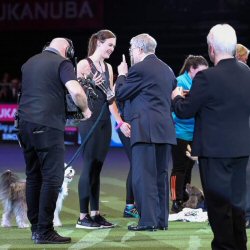 |
In
his latter years, Peter developed a new interest in growing fuchsias. Not
unexpectedly Peter's hobby became a bit of an obsession and, once again, he found
a competitive element to take his interest. He became a serial and major winner
at this, too - the highlight being his win at the British Fuschia Society's 75th
Anniversary Celebration Show at RHS Wisley
So
in summary Peter got a dog, trained it, won a few trials, wrote some books,
developed rules for some new dog pastimes, visited some countries promoting
them, owned and trained more dogs, reinvented his interests and made a success
of them all. I
only hope I have done one of the great agility pioneers justice in writing this
obituary. He was an innovator, an organiser and administrator - someone who
actually did things and delivered on his ideas. He didn't just talk about them.
I think those of us that have followed have a lot to be grateful for.
 About the author... About the author...
Steve Croxford
first met Peter Lewis in
1991 when his wife Yvonne qualified to
represent the British Team at the Royal Canin Agility Masters at the Bercy Arena
in Paris. Other Team members included Don
Cooper, Sandy Bell and Gill McCullock, and Steve travelled with them as a willing
groom. At the time, he did not know realise how influential Peter and Jean-Paul had been
in developing Agility, in particular how they persuaded the FCI to adopt Agility a sport. It very much
down to their influence that Agility competitions are run to more or less the
same rules worldwide.
Steve
got to know Peter very
well in 2001 when he was GB Agility Team Manager, the year when the UK first took
part in the FCI World Agility Championships.
Amongst others, it was with Peter's encouragement that
Steve became involved with
The Kennel Club and he says it has been an honour to follow in his footsteps. He
was elected Vice Chairman in 2015 and Chairman of the Board in 2018, a post
which he held for a year. He subsequently left the Board but continues to
contribute to agility through various committees, and he represents the UK
Kennel Club at FCI Agility Commission meetings.
First published 6th February 2023
| 
About the author...